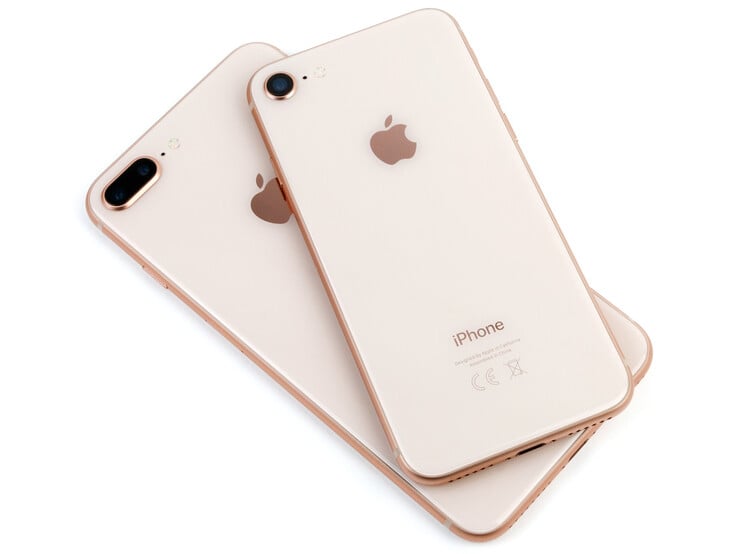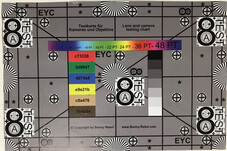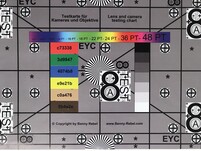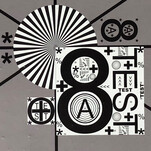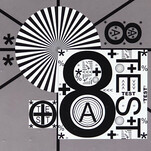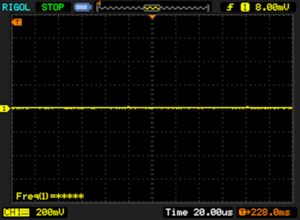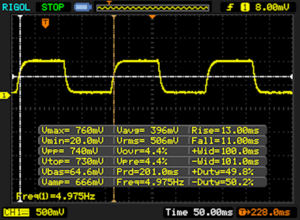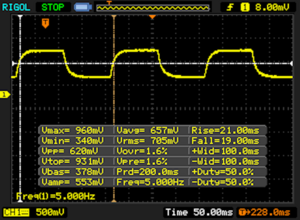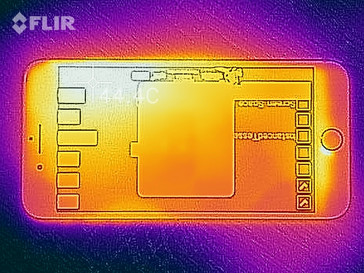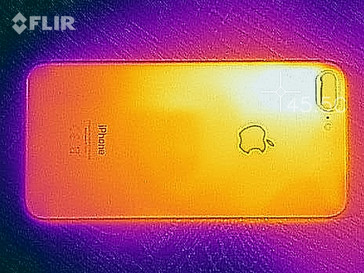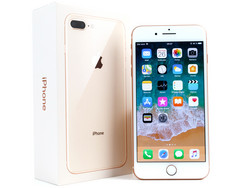Breve Análise do Smartphone Apple iPhone 8 Plus
Os Top 10
» Os Top 10 Portáteis Multimídia
» Os Top 10 Portáteis de Jogos
» Os Top 10 Portáteis Leves para Jogos
» Os Top 10 Portáteis Acessíveis de Escritório/Empresariais
» Os Top 10 Portáteis Premium de Escritório/Empresariais
» Os Top 10 dos Portáteis Workstation
» Os Top 10 Subportáteis
» Os Top 10 Ultrabooks
» Os Top 10 Conversíveis
» Os Top 10 Tablets
» Os Top 10 Smartphones
» A melhores Telas de Portáteis Analisadas Pela Notebookcheck
» Top 10 dos portáteis abaixo dos 500 Euros da Notebookcheck
» Top 10 dos Portáteis abaixo dos 300 Euros
| |||||||||||||||||||||||||
iluminação: 90 %
iluminação com acumulador: 559 cd/m²
Contraste: 1471:1 (Preto: 0.38 cd/m²)
ΔE ColorChecker Calman: 1.3 | ∀{0.5-29.43 Ø4.78}
ΔE Greyscale Calman: 1.8 | ∀{0.09-98 Ø5}
99.9% sRGB (Calman 2D)
Gamma: 2.25
CCT: 6797 K
| Apple iPhone 8 Plus A11 Bionic GPU, A11 Bionic, Apple 256 GB (iPhone 8 / Plus) | Apple iPhone 8 A11 Bionic GPU, A11 Bionic, Apple 256 GB (iPhone 8 / Plus) | Apple iPhone 7 Plus A10 Fusion GPU, A10 Fusion, 128 GB NVMe | Samsung Galaxy S8 Plus Mali-G71 MP20, Exynos 8895, 64 GB UFS 2.1 Flash | Huawei Mate 9 Mali-G71 MP8, Kirin 960, 64 GB UFS 2.1 Flash | |
|---|---|---|---|---|---|
| Screen | 4% | 4% | -7% | -74% | |
| Brightness middle (cd/m²) | 559 | 604 8% | 557 0% | 560 0% | 696 25% |
| Brightness (cd/m²) | 538 | 580 8% | 553 3% | 562 4% | 680 26% |
| Brightness Distribution (%) | 90 | 91 1% | 97 8% | 93 3% | 93 3% |
| Black Level * (cd/m²) | 0.38 | 0.44 -16% | 0.35 8% | 0.42 -11% | |
| Contrast (:1) | 1471 | 1373 -7% | 1591 8% | 1657 13% | |
| Colorchecker dE 2000 * | 1.3 | 1.2 8% | 1.4 -8% | 1.7 -31% | 4.3 -231% |
| Colorchecker dE 2000 max. * | 2.7 | 2.3 15% | 3.1 -15% | 3.4 -26% | 9.4 -248% |
| Greyscale dE 2000 * | 1.8 | 1.6 11% | 1.3 28% | 1.6 11% | 4.8 -167% |
| Gamma | 2.25 98% | 2.25 98% | 2.21 100% | 2.13 103% | 2.33 94% |
| CCT | 6797 96% | 6688 97% | 6667 97% | 6435 101% | 7255 90% |
| Color Space (Percent of AdobeRGB 1998) (%) | 63.1 | 81.57 | |||
| Color Space (Percent of sRGB) (%) | 99.83 | 99.87 |
* ... menor é melhor
Cintilação da tela / PWM (modulação por largura de pulso)
| Tela tremeluzindo / PWM não detectado | |||
[pwm_comparison] Em comparação: 53 % de todos os dispositivos testados não usam PWM para escurecer a tela. Se PWM foi detectado, uma média de 8111 (mínimo: 5 - máximo: 343500) Hz foi medida. | |||
Exibir tempos de resposta
| ↔ Tempo de resposta preto para branco | ||
|---|---|---|
| 24 ms ... ascensão ↗ e queda ↘ combinadas | ↗ 13 ms ascensão | |
| ↘ 11 ms queda | ||
| A tela mostra boas taxas de resposta em nossos testes, mas pode ser muito lenta para jogadores competitivos. Em comparação, todos os dispositivos testados variam de 0.1 (mínimo) a 240 (máximo) ms. » 53 % de todos os dispositivos são melhores. Isso significa que o tempo de resposta medido é pior que a média de todos os dispositivos testados (20.2 ms). | ||
| ↔ Tempo de resposta 50% cinza a 80% cinza | ||
| 40 ms ... ascensão ↗ e queda ↘ combinadas | ↗ 21 ms ascensão | |
| ↘ 19 ms queda | ||
| A tela mostra taxas de resposta lentas em nossos testes e será insatisfatória para os jogadores. Em comparação, todos os dispositivos testados variam de 0.165 (mínimo) a 636 (máximo) ms. » 60 % de todos os dispositivos são melhores. Isso significa que o tempo de resposta medido é pior que a média de todos os dispositivos testados (31.6 ms). | ||
| Geekbench 4.4 | |
| 64 Bit Single-Core Score (classificar por valor) | |
| Apple iPhone 8 Plus | |
| Apple iPhone 8 | |
| Apple iPhone 7 | |
| Huawei Mate 9 | |
| Samsung Galaxy S8 Plus | |
| Samsung Galaxy Note 8 | |
| 64 Bit Multi-Core Score (classificar por valor) | |
| Apple iPhone 8 Plus | |
| Apple iPhone 8 | |
| Apple iPhone 7 | |
| Huawei Mate 9 | |
| Samsung Galaxy S8 Plus | |
| Samsung Galaxy Note 8 | |
| Compute Metal Score 4.1 (classificar por valor) | |
| Apple iPhone 8 Plus | |
| Apple iPhone 8 | |
| Apple iPhone 7 | |
| AnTuTu v6 - Total Score (classificar por valor) | |
| Apple iPhone 8 Plus | |
| Apple iPhone 8 | |
| Apple iPhone 7 | |
| Huawei Mate 9 | |
| Samsung Galaxy S8 Plus | |
| Samsung Galaxy Note 8 | |
| Octane V2 - Total Score (classificar por valor) | |
| Apple iPhone 8 Plus | |
| Apple iPhone 8 | |
| Apple iPhone 7 | |
| Huawei Mate 9 | |
| Samsung Galaxy S8 Plus | |
| Samsung Galaxy Note 8 | |
| Mozilla Kraken 1.1 - Total (classificar por valor) | |
| Apple iPhone 8 Plus | |
| Apple iPhone 8 | |
| Apple iPhone 7 | |
| Huawei Mate 9 | |
| Samsung Galaxy S8 Plus | |
| Samsung Galaxy Note 8 | |
| WebXPRT 2015 - Overall (classificar por valor) | |
| Apple iPhone 8 Plus | |
| Apple iPhone 8 | |
| Apple iPhone 7 | |
| Huawei Mate 9 | |
| Samsung Galaxy S8 Plus | |
| Samsung Galaxy Note 8 | |
* ... menor é melhor
| GFXBench (DX / GLBenchmark) 2.7 | |
| T-Rex Onscreen (classificar por valor) | |
| Apple iPhone 8 Plus | |
| Apple iPhone 8 | |
| Apple iPhone 7 | |
| Huawei Mate 9 | |
| Samsung Galaxy S8 Plus | |
| Samsung Galaxy Note 8 | |
| 1920x1080 T-Rex Offscreen (classificar por valor) | |
| Apple iPhone 8 Plus | |
| Apple iPhone 8 | |
| Apple iPhone 7 | |
| Huawei Mate 9 | |
| Samsung Galaxy S8 Plus | |
| Samsung Galaxy Note 8 | |
| GFXBench 3.0 | |
| on screen Manhattan Onscreen OGL (classificar por valor) | |
| Apple iPhone 8 Plus | |
| Apple iPhone 8 | |
| Apple iPhone 7 | |
| Huawei Mate 9 | |
| Samsung Galaxy S8 Plus | |
| Samsung Galaxy Note 8 | |
| 1920x1080 1080p Manhattan Offscreen (classificar por valor) | |
| Apple iPhone 8 Plus | |
| Apple iPhone 8 | |
| Apple iPhone 7 | |
| Huawei Mate 9 | |
| Samsung Galaxy S8 Plus | |
| Samsung Galaxy Note 8 | |
| GFXBench 3.1 | |
| on screen Manhattan ES 3.1 Onscreen (classificar por valor) | |
| Apple iPhone 8 Plus | |
| Apple iPhone 8 | |
| Apple iPhone 7 | |
| Huawei Mate 9 | |
| Samsung Galaxy S8 Plus | |
| Samsung Galaxy Note 8 | |
| 1920x1080 Manhattan ES 3.1 Offscreen (classificar por valor) | |
| Apple iPhone 8 Plus | |
| Apple iPhone 8 | |
| Apple iPhone 7 | |
| Huawei Mate 9 | |
| Samsung Galaxy S8 Plus | |
| Samsung Galaxy Note 8 | |
| Octane V2 - Total Score (classificar por valor) | |
| Apple iPhone 8 Plus | |
| Apple iPhone 8 | |
| Apple iPhone 7 | |
| Huawei Mate 9 | |
| Samsung Galaxy S8 Plus | |
| Samsung Galaxy Note 8 | |
| JetStream 1.1 - Total Score (classificar por valor) | |
| Apple iPhone 8 Plus | |
| Apple iPhone 8 | |
| Apple iPhone 7 | |
| Huawei Mate 9 | |
| Samsung Galaxy S8 Plus | |
| Samsung Galaxy Note 8 | |
| Mozilla Kraken 1.1 - Total (classificar por valor) | |
| Apple iPhone 8 Plus | |
| Apple iPhone 8 | |
| Apple iPhone 7 | |
| Huawei Mate 9 | |
| Samsung Galaxy S8 Plus | |
| Samsung Galaxy Note 8 | |
| WebXPRT 2015 - Overall (classificar por valor) | |
| Apple iPhone 8 Plus | |
| Apple iPhone 8 | |
| Apple iPhone 7 | |
| Huawei Mate 9 | |
| Samsung Galaxy S8 Plus | |
| Samsung Galaxy Note 8 | |
* ... menor é melhor
(±) A temperatura máxima no lado superior é 40.7 °C / 105 F, em comparação com a média de 35.2 °C / 95 F , variando de 21.9 a 247 °C para a classe Smartphone.
(±) A parte inferior aquece até um máximo de 40.6 °C / 105 F, em comparação com a média de 34 °C / 93 F
(+) Em uso inativo, a temperatura média para o lado superior é 28.1 °C / 83 F, em comparação com a média do dispositivo de 32.9 °C / ### class_avg_f### F.
Apple iPhone 8 Plus análise de áudio
(±) | o volume do alto-falante é médio, mas bom (###valor### dB)
Graves 100 - 315Hz
(-) | quase nenhum baixo - em média 17.1% menor que a mediana
(±) | a linearidade dos graves é média (7.5% delta para a frequência anterior)
Médios 400 - 2.000 Hz
(+) | médios equilibrados - apenas 2.7% longe da mediana
(+) | médios são lineares (4.5% delta para frequência anterior)
Altos 2 - 16 kHz
(+) | agudos equilibrados - apenas 4.3% longe da mediana
(+) | os máximos são lineares (3.8% delta da frequência anterior)
Geral 100 - 16.000 Hz
(±) | a linearidade do som geral é média (16.5% diferença em relação à mediana)
Comparado com a mesma classe
» 7% de todos os dispositivos testados nesta classe foram melhores, 5% semelhantes, 88% piores
» O melhor teve um delta de 11%, a média foi 35%, o pior foi 134%
Comparado com todos os dispositivos testados
» 27% de todos os dispositivos testados foram melhores, 6% semelhantes, 67% piores
» O melhor teve um delta de 4%, a média foi 24%, o pior foi 134%
Huawei P10 Plus análise de áudio
(±) | o volume do alto-falante é médio, mas bom (###valor### dB)
Graves 100 - 315Hz
(-) | quase nenhum baixo - em média 17.3% menor que a mediana
(±) | a linearidade dos graves é média (12.4% delta para a frequência anterior)
Médios 400 - 2.000 Hz
(+) | médios equilibrados - apenas 3.1% longe da mediana
(+) | médios são lineares (6.9% delta para frequência anterior)
Altos 2 - 16 kHz
(+) | agudos equilibrados - apenas 1% longe da mediana
(+) | os máximos são lineares (3.9% delta da frequência anterior)
Geral 100 - 16.000 Hz
(±) | a linearidade do som geral é média (16.8% diferença em relação à mediana)
Comparado com a mesma classe
» 8% de todos os dispositivos testados nesta classe foram melhores, 7% semelhantes, 85% piores
» O melhor teve um delta de 11%, a média foi 35%, o pior foi 134%
Comparado com todos os dispositivos testados
» 29% de todos os dispositivos testados foram melhores, 7% semelhantes, 64% piores
» O melhor teve um delta de 4%, a média foi 24%, o pior foi 134%
HTC U11 análise de áudio
(±) | o volume do alto-falante é médio, mas bom (###valor### dB)
Graves 100 - 315Hz
(-) | quase nenhum baixo - em média 24.5% menor que a mediana
(±) | a linearidade dos graves é média (13.3% delta para a frequência anterior)
Médios 400 - 2.000 Hz
(+) | médios equilibrados - apenas 4.1% longe da mediana
(±) | a linearidade dos médios é média (7.4% delta para frequência anterior)
Altos 2 - 16 kHz
(±) | máximos mais altos - em média 5.1% maior que a mediana
(+) | os máximos são lineares (6.2% delta da frequência anterior)
Geral 100 - 16.000 Hz
(±) | a linearidade do som geral é média (22.1% diferença em relação à mediana)
Comparado com a mesma classe
» 46% de todos os dispositivos testados nesta classe foram melhores, 7% semelhantes, 47% piores
» O melhor teve um delta de 11%, a média foi 35%, o pior foi 134%
Comparado com todos os dispositivos testados
» 63% de todos os dispositivos testados foram melhores, 6% semelhantes, 31% piores
» O melhor teve um delta de 4%, a média foi 24%, o pior foi 134%
| desligado | |
| Ocioso | |
| Carga |
|
Key:
min: | |
| Apple iPhone 8 Plus A11 Bionic GPU, A11 Bionic, Apple 256 GB (iPhone 8 / Plus) | Apple iPhone 8 A11 Bionic GPU, A11 Bionic, Apple 256 GB (iPhone 8 / Plus) | Apple iPhone 7 Plus A10 Fusion GPU, A10 Fusion, 128 GB NVMe | Samsung Galaxy S8 Plus Mali-G71 MP20, Exynos 8895, 64 GB UFS 2.1 Flash | Huawei Mate 9 Mali-G71 MP8, Kirin 960, 64 GB UFS 2.1 Flash | Sony Xperia XZ Premium Adreno 540, SD 835, 64 GB UFS 2.0 Flash | Google Pixel XL 2016 Adreno 530, SD 821, 32 GB eMMC Flash | OnePlus 5 Adreno 540, SD 835, 64 GB UFS 2.1 Flash | |
|---|---|---|---|---|---|---|---|---|
| Duração da bateria | -10% | -1% | 5% | 6% | 3% | -21% | -12% | |
| Reader / Idle (h) | 34.8 | 27.2 -22% | 30.6 -12% | 26.1 -25% | 25.6 -26% | 29.2 -16% | 22.2 -36% | 25.6 -26% |
| H.264 (h) | 12.2 | 11.6 -5% | 13.6 11% | 12.4 2% | 15.8 30% | 13.4 10% | 8.4 -31% | 10.4 -15% |
| WiFi v1.3 (h) | 11 | 9.8 -11% | 9.8 -11% | 12.3 12% | 12.6 15% | 11.6 5% | 8.4 -24% | 8.6 -22% |
| Load (h) | 3.5 | 3.4 -3% | 3.8 9% | 4.6 31% | 3.7 6% | 3.9 11% | 3.8 9% | 4.1 17% |
Pro
Contra
O iPhone 8 Plus oferece um pouco mais que o seu irmão menor. Não estamos apenas falando sobre o peso puro, que é substancial com mais de 200 gramas, mas principalmente a câmera dupla. A tela também possui mais pixels e você recebe 1 GB de RAM a mais. A carcaça retrabalhada com o painel traseiro de vidro deixa impressões misturadas. A qualidade de construção é ótima, e é conveniente ao toque. No entanto, a superfície parece manchada após alguns minutos. O modelo Plus também é realmente grande para um smartphone com uma tela de 5,5 polegadas.
A câmera é muito similar à do iPhone 7 Plus e o segundo lente oferece um zoom ótico 2x. Ele também habilita o efeito soft Bokeh para retratos, o qual se vê muito bem. A qualidade da imagem, em geral, foi melhorada, em comparação com o modelo anterior, e agora você pode gravar vídeo em UltraHD com até 60 quadros por segundo. FullHD é possível com até 240 FPS, o qual cria vídeo em câmera lenta espetaculares. O iPhone 8 Plus certamente é o melhor pacote de câmera que você pode adquiri hoje em dia em um smartphone – se gostar do menu de configurações essenciais.
O iPhone 8 Plus é uma ótima escolha para os entusiastas do vídeo. Se você planeja comprá-lo para este propósito, no entanto, você deve estar disposto a pagar pelo modelo maior de 256 GB, porque 4K @60 FPS requer muito espaço de armazenamento.
O novo SoC A11 é mais uma vez muito mais rápido e fora do alcance dos rivais. Você também recebe LTE veloz, longas durações da bateria, e uma carcaça resistente à água e à poeira. Similar ao seu irmão menor, não podemos encontrar falhas maiores, mas algumas coisas são irritantes. Isto inclui a garantia limitada e o fraco adaptador de força. A qualidade da voz poderia ser melhor nas redes 3G e o som é apenas médio, apesar dos alto-falantes estéreo.
O movimento da Apple em direção à Realidade Aumentada é importante e certamente será bem sucedido graças à grande plataforma e ao enorme potencial de usuários para avanços rápidos e lucrativos na tecnologia. A RA já funciona bem, mas ainda não pe tão precisa ou sofisticada em comparação com a do Asus Zenfone AR, por exemplo.
Em suma, o iPhone 8 Plus é um ótimo produto com componentes de gama alta, mas o smartphone e os acessórios úteis também são muito caros.
Apple iPhone 8 Plus
- 10/15/2018 v6 (old)
Daniel Schmidt, Patrick Afschar Kaboli




